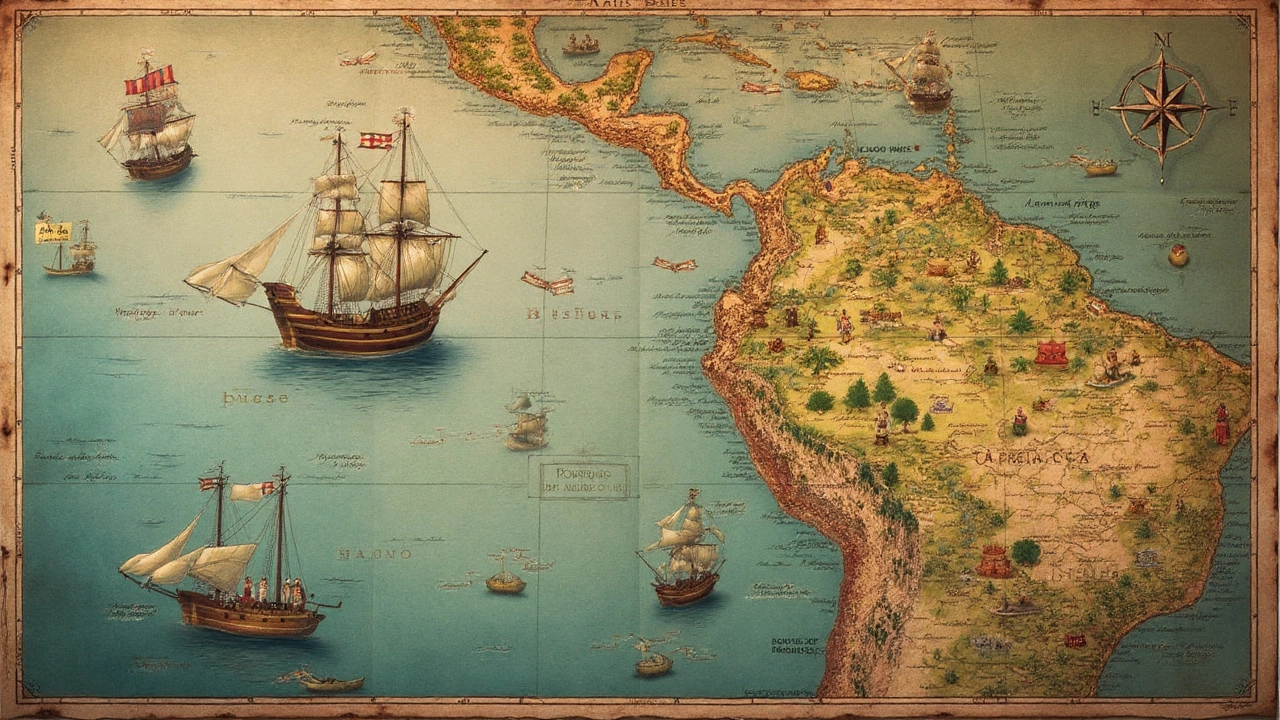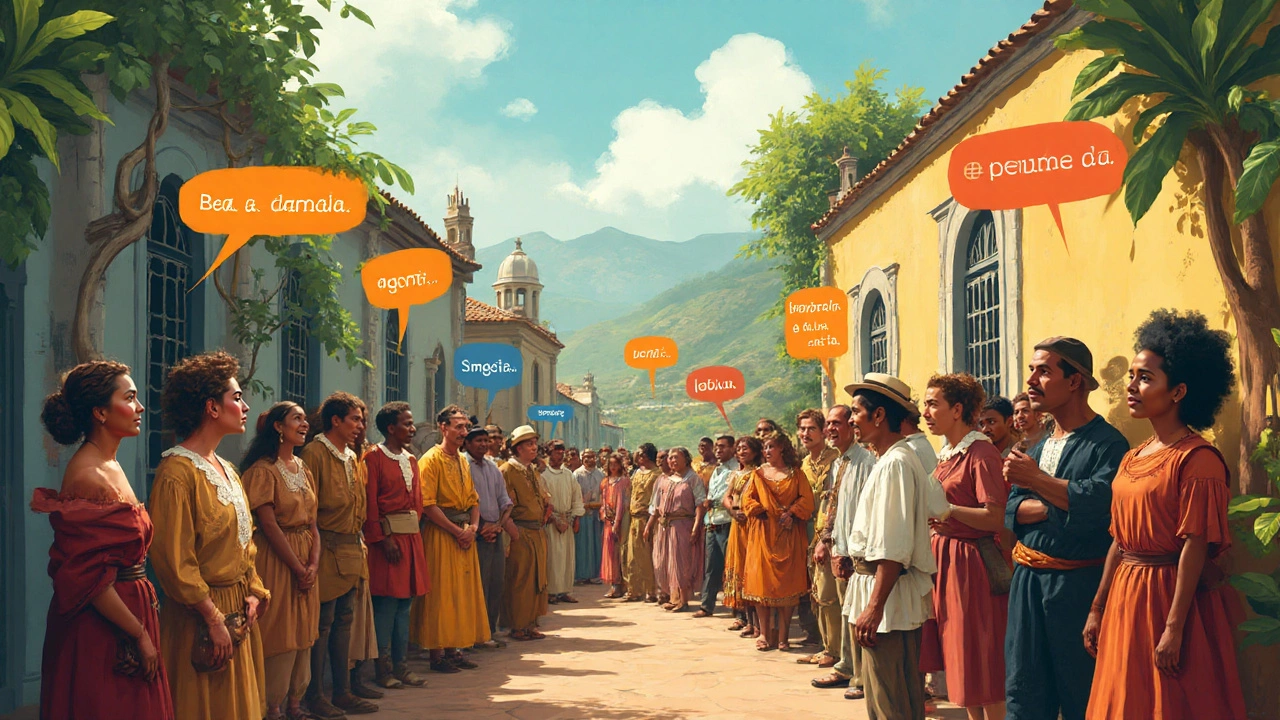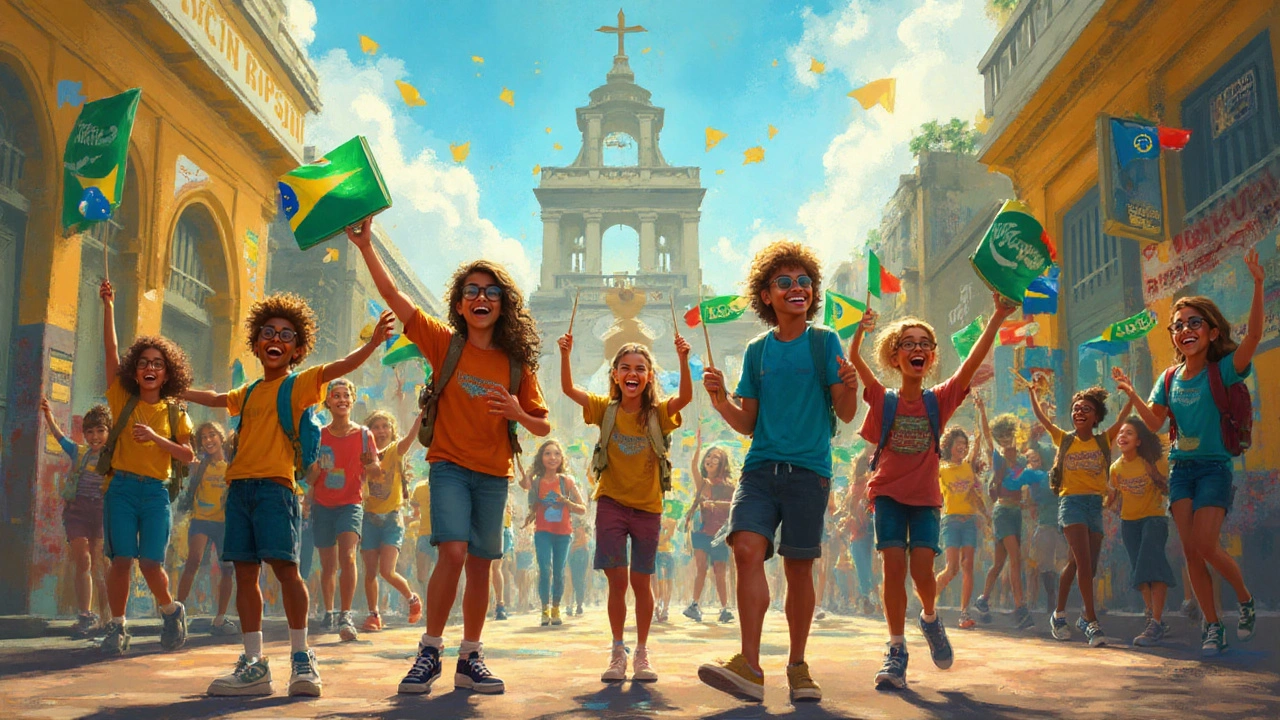Why Do Brazilians Speak Portuguese? History, Language, and Surprising Facts

Grab a map and let your eyes wander to South America. See how enormous Brazil looks? Now, take in this wild fact: it's the only country on that landmass speaking Portuguese, not Spanish, despite being surrounded by Spanish-speaking neighbors. Ever found yourself asking why? You’re not alone. At soccer matches during the World Cup, you’ll hear Brazilian fans chanting in Portuguese, baffling travelers who expected Spanish. This language twist isn’t some tiny historical footnote—it’s a story tangled up in treaties, colonial ambition, and culture clashes. Forget the usual dry, textbook answers. If you want the real reason Brazilians aren’t saying “hola” but “olá,” keep reading—you’ll see history from a totally new angle.
The Real Reason: Carving Up the New World
Let’s ditch the rumor that Brazil just "chose" Portuguese on a whim. Go back to 1494. Europe was obsessed with maps, gold, and adventure, and Spain and Portugal were elbowing each other for more land and glory. They struck a deal called the Treaty of Tordesillas. The Pope himself drew a line through the Atlantic, basically saying, “Spain, you get one chunk. Portugal, here’s yours.” No one asked Indigenous people living there, of course. But this line just happened to carve out a huge part of future Brazil for Portugal. The rest? Spain grabbed it all. Suddenly, destiny set—Brazil spoke Portuguese, everyone else went Spanish.
Portugal’s ships landed in what they called “Terra de Vera Cruz”—or the Land of the True Cross—in 1500. The explorers probably didn’t even realize how massive the territory was. They started small: outposts, trade with locals, and lots of letter-writing home about dreamy opportunities. Meanwhile, Spanish colonies popped up everywhere else, following strict rules from Madrid. When new, more accurate maps arrived (big thanks to geographers improving their skills), the Portuguese realized their chunk was even juicier than they’d thought. They kept pushing the borders, ignoring old agreements. That’s why Brazil stretches so wide across the continent today.
For a sense of scale: Brazil now covers about 47% of South America’s landmass. Check out this simple table to put things in perspective:
| Country | Main Language | Land Area (sq km) |
|---|---|---|
| Brazil | Portuguese | 8,515,767 |
| Argentina | Spanish | 2,780,400 |
| Colombia | Spanish | 1,141,748 |
| Peru | Spanish | 1,285,216 |
Language stuck because of politics and power, not personal preference. Portuguese became the official tongue early in Brazil’s European history, putting down roots that stuck for centuries.
What Happened to Indigenous and Other Languages?
Before the Portuguese arrived, Brazil was anything but linguistically simple. Thousands of Native tribes had their own languages—estimates put the number at over a thousand. Tupi, Guarani, and scores of other tongues thrived for generations. When the Portuguese colonized the coast, they encountered this mosaic of languages, and for a time, a mix called Língua Geral (General Language) became a kind of bridge language. Think of it like Spanglish, but with Tupi as a base, and Portuguese words sprinkled in.
Missionaries, Jesuits especially, dove into learning and writing down Indigenous languages. But soon the authorities in Lisbon got nervous. What if people stayed loyal to local traditions instead of the Crown? By 1757, the Portuguese king clamped down, banning most Native languages and forcing everyone to use Portuguese everywhere for school, government, and business. This wiped out a ton of linguistic diversity over generations. Even so, if you listen carefully in northern Brazil, you’ll still hear bits of Tupi words—like “piranha,” “jacaré” (alligator), or “capivara” (capybara) in daily speech. It’s a ghostly echo, but it lingers.
There was immigration, too. In the late 1800s and early 1900s, millions of Italians, Germans, and Japanese arrived in Brazil searching for a better life. Communities in São Paulo and the south still treasure phrases and idioms from those roots. But the government’s policy was strict: learn and use Portuguese as your main language, or you’d never fit in. That’s why today, over 98% of Brazilians speak Portuguese natively, an eye-popping figure compared to other multicultural countries.
So, Brazil’s unique language vibe is the legacy of colonial laws, Indigenous resilience, and immigrant adaptation, all swirled together. It’s a Brazilian thing—their Portuguese isn’t quite like the kind you’ll hear in Lisbon, but more on that soon.

Why Not Spanish? Myths and Mix-Ups
People outside South America often assume all Latin Americans speak Spanish. Maybe it’s all those telenovelas or the similarity between Spanish and Portuguese that causes confusion. But plenty of travelers get a shock when their high school Spanish stalls out in São Paulo or Rio.
Despite borders with nine Spanish-speaking countries, Brazil stays linguistically separate. Portuguese has different sounds, accents, and even its own “singsong” rhythm—not to mention unique expressions. For example, Brazilians say “legal” for “cool,” while Spanish speakers stick with “chévere” or “guay.” The subtle, musical “ão” sound in words like “coração” (heart) or “pão” (bread) just doesn’t have a Spanish twin.
Here’s where it gets fun: if you know Spanish, you can probably read simple Portuguese newspaper headlines and get the gist. But try having a conversation and you’ll hit snags. Grammar twists, pronunciation quirks, and slang pull the two languages apart. A fun fact—Brazilians often joke about “portunhol,” a silly mix of Spanish and Portuguese that ends up confusing both sides.
There are serious stories behind the myth. In 2009, Brazil made Spanish a mandatory subject in public schools, hoping to bridge gaps with its neighbors. But most students found it extra tough to juggle two similar, yet frustratingly different languages. The policy was quietly dropped in 2020. English lessons are more common now, especially for those dreaming of jobs in tourism or with international companies.
One look at how language shapes national identity shows why Brazilian language pride runs deep. Soccer fans, for example, will belt out the national anthem in perfect Portuguese, while donning Neymar jerseys—even though the rest of the continent is yelling “gol” in Spanish. This isn’t just a quirk, but a badge of cultural independence.
Brazilian Portuguese: Its Own Flavor
Some people imagine Brazilian Portuguese as just a “lazy” or “sunny” version of European Portuguese. That’s way off. Since those first explorers set foot on the sandy beaches, the language has absorbed Indigenous flavors, African words (from the millions brought over during the slave trade), and a grab-bag of immigrant twists.
Brazilians rarely say “tu” (you), except in the south. They go with “você” for everyone, sometimes adding “senhor” or “senhora” for respect, like “Mr.” or “Ma’am.” Listen in big cities like Rio or Salvador and you’ll hear different slang and music shapes language daily. Samba musicians helped turn phrases like “bamba,” “malandro,” and “ginga” mainstream—words packed with attitude, rhythm, and street smarts.
The accents aren’t all one kind, either. Southern Brazilians slide their “s” like a soft “sh” (think “paixão” said as “paishão”), while folks from Bahia speak in a melodic drawl that feels almost like singing. Up north, you’ll catch Amazonian intonations you won’t hear anywhere else. Regional food words, place names, and even sports terms carry traces of Tupi, African Bantu, Japanese, German, Syrian, and Italian backgrounds.
If you visit, don’t stress about formal grammar. Brazilians are famously patient with newbies. Smile, toss in a friendly “tudo bem?” (all good?), and you’re golden. The warmth and humor built into their language reflects their national character—open, adaptable, and never too worried about rules.

Curious Language Facts and Tips for Visitors
Feeling ready to dive deeper into why Brazil speaks Portuguese, not Spanish? Here are some facts that even seasoned travelers might not know—and a few tips if you’re planning a trip:
- Brazil is the largest Portuguese-speaking country on earth. In fact, more than four out of every five Portuguese speakers live in Brazil, not Portugal.
- Brazilian Portuguese has dozens of unique words for simple things. For example, coffee can be “cafezinho” (a small, strong cup) or “pingado” (coffee with a splash of milk) depending on the region.
- Every state has its own accent and slang. Cariocas from Rio speak quickly, while people from Minas Gerais are famous for stretching vowels and softening consonants.
- Key phrases will take you far: “obrigado” or “obrigada” for thank you, “com licença” for excuse me, and “desculpa” for sorry. Master these and locals will love you for trying.
- If you plan to watch a soccer match, shouting “gol” is universal, but don’t forget to listen for Brazilian songs with lines like “sou brasileiro, com muito orgulho!” (I’m Brazilian, so proud!).
A couple of bonus table facts:
| Interesting Language Fact | Detail |
|---|---|
| Word for "Soccer" | Futebol (Brazil Portuguese), Fútbol (Spanish neighbors), Football (England) |
| "Thank You" | Obrigado (men) / Obrigada (women) in Brazil, Gracias in Spanish |
| Unique Sport Chant | "Eu sou brasileiro, com muito orgulho, com muito amor!" |
| Number of Dialects | More than 16 major regional accents in Brazilian Portuguese |
If you’re visiting, don’t worry if you slip into Spanish by accident—most Brazilians will help you out, and you’ll quickly pick up some basics. And if you tune in to a soccer game, notice how fans put their own spin on everything, language included. The real heart of Brazilian culture is in the way they speak: friendly, musical, and always full of surprises.
